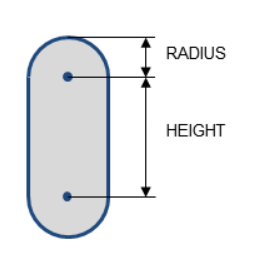缘由
网友:KeepSmile 提出来能否做一个双击之后,跑过去的例子。大家如果在学习或工作中实现某个功能上需要我写一些例子和分析,可以在本文之后把功能描述清楚在评论区回复或在群里留言,我会帮忙写一些例子和解析。我的目标是用最简单的代码帮最大的忙 _
完整代码在本文最后的代码块和网盘中:
功能
场景: 20×20米的格子。中间放着一个坐标轴。
启动场景: 有一个5秒的开场动画,从(0.0, -18, 1.0)缓缓推到(0.0, -8, 1.0)。
操作: 在场景格子上双击,双击后会在交点处加个球,然后视点会花两秒钟转过去,花三秒钟跑过去。在这个过程中你还可以双击别处,又会转往别处,跑往别处。如果当前朝向和点的球的朝向是一致的,也就是不需要转脑袋,则视点直接花5秒跑过去,不需要花2秒钟头。
实现关键点
操作器: 使用osgGA::AnimationPathManipulator,这个操作器可以使用AnimationPath做为入参。因此最关键的就是如何生成AnimationPath
生成路径: 路径的生成靠关键点,关键点有三个参数,一个是时间,一个是位置,一个是朝向。如下:
if (fromRotate != rotate1)//代表不需要给时间转方向,当起点的方向和终点的方向是一致的时候,就不需要转方向
{
//给2秒钟转方向,起点不变,只有方向变
animationPath->insert(2, osg::AnimationPath::ControlPoint(from, rotate1));
}
animationPath->insert(5, osg::AnimationPath::ControlPoint(to, rotate1));
其中5就是时间,也就是路径开始的时候第5S要跑到to, 朝向是rotate1,在两个点的间隔之间,会自动的位置和朝向都进行插值。
事件处理: 在双击时,求交点,画球。我们专门写了个事件处理器MyEventHandler来做事件处理,然后获取当前视点和朝向做为起点,将交点做为终点,使用createAnimationByTwoPoints函数生成一个路径。设置到AnimationPathManipulator当中,注意将AnimationPathManipulator的时间设置为当前仿真时间的取负,也即:_apm->setTimeOffset(-ea.getTime());。这里估计是OSG的BUG,按说setTimeOffset设置成0就代表重新开始。但是源码里是仿真时间+时间偏移,因此动画要想重播,仿真时间就要被减掉。对应代码是:
if (view->computeIntersections(ea, intersections))
{
//有交点,先画个球
osg::Vec3 hitPoint = intersections.begin()->getWorldIntersectPoint();
_root->addChild(CreateSphere(hitPoint));
//操作器切换成animationPath操作器,创建animationPath直接跑过去
//获取当前视点信息
osg::Vec3 eye, center, up;
view->getCamera()->getViewMatrixAsLookAt(eye, center, up);
//得到当前视点的朝向
osg::Matrix viewMatrix = view->getCamera()->getInverseViewMatrix();
_apm->setAnimationPath(createAnimationByTwoPoints(eye, viewMatrix.getRotate(),hitPoint));
//减去当前仿真时间重头开始播,停个timeoffset设置的不太合理
//按说设置成0就应该是从头播了,但是其实现加了当前仿真时间,有点怪怪的
_apm->setTimeOffset(-ea.getTime());
}
这样就实现了生成的路径始终以当前视点和朝向为起点,以双击地面的小球为终点。终点时的朝向是由起点和终点的连线决定,可以看看代码,弄不清楚的话建议看看上一篇第09节,里面讲的非常清晰。
#include <osgViewer/viewer>
#include <osgDB/ReadFile>
#include <osg/Geode>
#include <osg/Geometry>
#include <osgGA/CameraManipulator>
#include <osgGA/AnimationPathManipulator>
#include <osg/ShapeDrawable>
//定义全局变量用着方便
osgGA::AnimationPathManipulator* _apm = new osgGA::AnimationPathManipulator;
osg::Group* _root = nullptr;
osg::Node* _base = nullptr;
osg::AnimationPath* createAnimationByTwoPoints(osg::Vec3 from, osg::Quat fromRotate, osg::Vec3 to)
{
//防止视点贴地面太近
if (from.z() < 1.0) from.z() = 1.0;
if (to.z() < 1.0) to.z() = 1.0;
osg::AnimationPath* animationPath = new osg::AnimationPath;
animationPath->setLoopMode(osg::AnimationPath::NO_LOOPING);
animationPath->insert(0, osg::AnimationPath::ControlPoint(from, fromRotate));
osg::Quat rotate1(osg::inDegrees(90.0), osg::X_AXIS);
osg::Vec3 tf = to - from;
//经X旋转90度以后,视点已经朝向y轴正方向
//当x,y都大于0在第一四象限,要顺时针旋转theta
float theta = 0;
if (tf.x() > 0.000001)//一四象限
{
rotate1 *= osg::Quat(std::atan(tf.y() / tf.x()) - osg::inDegrees(90.0), osg::Z_AXIS);
}
else if (tf.x() < -0.000001)//二三象限
{
rotate1 *= osg::Quat(osg::inDegrees(90.0) + std::atan(tf.y() / tf.x()), osg::Z_AXIS);
}
else //x=0
{
if (tf.y() > 0)
{
//啥也不用做,默认朝y轴正方向
}
else
{
//转180,朝y轴负方向
rotate1 *= osg::Quat(osg::PI, osg::Z_AXIS);
}
}
if (fromRotate != rotate1)//代表不需要给时间转方向,当起点的方向和终点的方向是一致的时候,就不需要转方向
{
//给2秒钟转方向,起点不变,只有方向变
animationPath->insert(2, osg::AnimationPath::ControlPoint(from, rotate1));
}
animationPath->insert(5, osg::AnimationPath::ControlPoint(to, rotate1));
return animationPath;
}
//画一个小球
osg::Geode* CreateSphere(osg::Vec3 center)
{
osg::Geode* gnode = new osg::Geode;
osg::ShapeDrawable* sd = new osg::ShapeDrawable(new osg::Sphere(center, 0.1));
gnode->addDrawable(sd);
return gnode;
}
class MyEventHandler : public osgGA::GUIEventHandler
{
public:
MyEventHandler() {}
virtual bool handle(const osgGA::GUIEventAdapter& ea, osgGA::GUIActionAdapter& aa)
{
//双击则加个球在击处,然后寻路过去
if (ea.getEventType() == ea.DOUBLECLICK)
{
if (ea.getButton() == ea.LEFT_MOUSE_BUTTON)
{
//与地板求交
osgUtil::LineSegmentIntersector::Intersections intersections;
osgViewer::View* view = dynamic_cast<osgViewer::View*>(&aa);
if (view->computeIntersections(ea, intersections))
{
//有交点,先画个球
osg::Vec3 hitPoint = intersections.begin()->getWorldIntersectPoint();
_root->addChild(CreateSphere(hitPoint));
//操作器切换成animationPath操作器,创建animationPath直接跑过去
//获取当前视点信息
osg::Vec3 eye, center, up;
view->getCamera()->getViewMatrixAsLookAt(eye, center, up);
//得到当前视点的朝向
osg::Matrix viewMatrix = view->getCamera()->getInverseViewMatrix();
_apm->setAnimationPath(createAnimationByTwoPoints(eye, viewMatrix.getRotate(),hitPoint));
//减去当前仿真时间重头开始播,停个timeoffset设置的不太合理
//按说设置成0就应该是从头播了,但是其实现加了当前仿真时间,有点怪怪的
_apm->setTimeOffset(-ea.getTime());
}
}
}
return false;
}
};
osg::Node* createBase(const osg::Vec3 center, float radius)
{
osg::Group* root = new osg::Group;
_root = root;
int numTilesX = 10;
int numTilesY = 10;
float width = 2 * radius;
float height = 2 * radius;
osg::Vec3 v000(center - osg::Vec3(width * 0.5f, height * 0.5f, 0.0f));
osg::Vec3 dx(osg::Vec3(width / ((float)numTilesX), 0.0, 0.0f));
osg::Vec3 dy(osg::Vec3(0.0f, height / ((float)numTilesY), 0.0f));
// fill in vertices for grid, note numTilesX+1 * numTilesY+1...
osg::Vec3Array* coords = new osg::Vec3Array;
int iy;
for (iy = 0; iy <= numTilesY; ++iy)
{
for (int ix = 0; ix <= numTilesX; ++ix)
{
coords->push_back(v000 + dx * (float)ix + dy * (float)iy);
}
}
//Just two colours - black and white.
osg::Vec4Array* colors = new osg::Vec4Array;
colors->push_back(osg::Vec4(1.0f, 1.0f, 1.0f, 1.0f)); // white
colors->push_back(osg::Vec4(0.0f, 0.0f, 0.0f, 1.0f)); // black
osg::ref_ptr<osg::DrawElementsUShort> whitePrimitives = new osg::DrawElementsUShort(GL_QUADS);
osg::ref_ptr<osg::DrawElementsUShort> blackPrimitives = new osg::DrawElementsUShort(GL_QUADS);
int numIndicesPerRow = numTilesX + 1;
for (iy = 0; iy < numTilesY; ++iy)
{
for (int ix = 0; ix < numTilesX; ++ix)
{
osg::DrawElementsUShort* primitives = ((iy + ix) % 2 == 0) ? whitePrimitives.get() : blackPrimitives.get();
primitives->push_back(ix + (iy + 1) * numIndicesPerRow);
primitives->push_back(ix + iy * numIndicesPerRow);
primitives->push_back((ix + 1) + iy * numIndicesPerRow);
primitives->push_back((ix + 1) + (iy + 1) * numIndicesPerRow);
}
}
// set up a single normal
osg::Vec3Array* normals = new osg::Vec3Array;
normals->push_back(osg::Vec3(0.0f, 0.0f, 1.0f));
osg::Geometry* geom = new osg::Geometry;
geom->setVertexArray(coords);
geom->setColorArray(colors, osg::Array::BIND_PER_PRIMITIVE_SET);
geom->setNormalArray(normals, osg::Array::BIND_OVERALL);
geom->addPrimitiveSet(whitePrimitives.get());
geom->addPrimitiveSet(blackPrimitives.get());
osg::Geode* geode = new osg::Geode;
_base = geode;
geode->addDrawable(geom);
geode->getOrCreateStateSet()->setMode(GL_LIGHTING, osg::StateAttribute::OFF);
root->addChild(geode);
root->addChild(osgDB::readNodeFile("axes.osgt"));
return root;
}
int main()
{
osgViewer::Viewer viewer;
viewer.addEventHandler(new MyEventHandler());
osg::Quat rotate0(osg::inDegrees(90.0), osg::X_AXIS);
_apm->setAnimationPath(createAnimationByTwoPoints(osg::Vec3(0.0, -18, 1.0), rotate0, osg::Vec3(0.0, -8, 1.0)));
viewer.setCameraManipulator(_apm);
viewer.setSceneData(createBase(osg::Vec3(0.0, 0.0, 0.0), 20.0));
return viewer.run();
}









![[转]我国CAD软件产业亟待研究现状采取对策-卡核](https://www.caxkernel.com/wp-content/uploads/2024/07/frc-f080b20a9340c1a89c731029cb163f6a-212x300.png)








